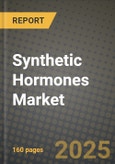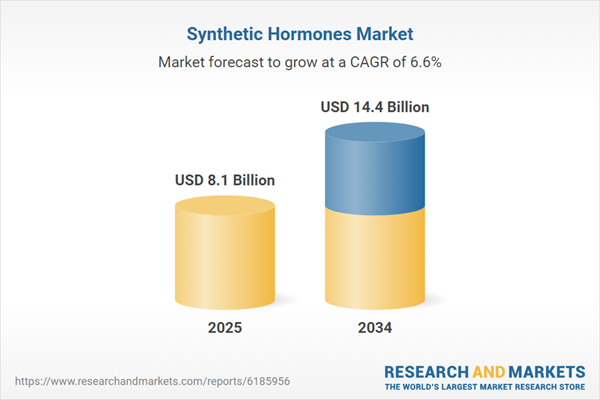The synthetic hormones market plays a vital role in modern medicine, offering therapeutic solutions for a wide range of hormonal imbalances and chronic conditions. Synthetic hormones, which mimic the function of naturally occurring hormones, are widely used in hormone replacement therapy (HRT), contraception, infertility treatments, growth disorders, and metabolic regulation. These formulations are engineered to be consistent, potent, and bioavailable, making them essential in both short-term treatments and long-term chronic disease management. The market is supported by a strong demand base, including aging populations, increasing endocrine disorders, and evolving reproductive health needs. While synthetic hormones have faced scrutiny regarding side effects and long-term risks, advancements in formulation and delivery technologies have improved safety and effectiveness profiles. With growing awareness and diagnosis rates for hormonal imbalances, particularly in women’s health and metabolic syndromes, synthetic hormones continue to be an integral part of the global pharmaceutical landscape.
The synthetic hormones market witnessed several significant developments across therapeutic areas and geographies. There was a marked increase in the adoption of bio-identical hormone replacement therapies, particularly in North America and Europe, driven by consumer preference for more “natural” synthetic options. Pharmaceutical companies introduced novel drug delivery systems, such as transdermal patches and long-acting injectables, which improved patient adherence and minimized hormone fluctuation side effects. The fertility treatment segment expanded rapidly with increased use of synthetic gonadotropins and progestins in assisted reproductive technologies. In the metabolic and growth hormone space, synthetic analogs gained traction for pediatric and adult growth disorders, supported by improvements in dosing precision. Regulatory agencies also updated guidelines to ensure clearer labeling and usage recommendations, fostering trust and more informed use among prescribers. Meanwhile, research continued to explore safer synthetic alternatives that reduced the risk of cardiovascular events and hormone-sensitive cancers.
The synthetic hormones market is expected to grow in complexity and specialization, as precision medicine and personalized care models become more mainstream. Pharmaceutical R&D is anticipated to focus on tissue-selective hormone receptor modulators, aiming to deliver targeted efficacy with reduced systemic side effects. The market will likely benefit from increased digital health integration, enabling hormone level tracking and personalized dosage adjustments through wearable tech and mobile platforms. Emerging economies are also expected to expand access to synthetic hormone therapies through public health programs targeting women’s health and chronic endocrine conditions. Biosimilars in hormone therapies may gain regulatory traction, introducing more cost-effective options in hormone replacement and fertility treatment segments. However, public skepticism around hormone therapy safety and misinformation regarding synthetic hormones may continue to pose barriers, necessitating education campaigns and transparent clinical data dissemination to build wider confidence in their use.
Key Insights: Synthetic Hormones Market
- Growing demand for bio-identical and plant-based synthetic hormone formulations is reshaping product development pipelines in women’s health and HRT segments.
- Increased use of transdermal, subcutaneous, and sustained-release delivery technologies is enhancing therapy compliance and minimizing adverse effects.
- Rising reliance on synthetic hormones in fertility and IVF treatments is expanding their clinical use among reproductive-age populations.
- Digital tools for hormone level tracking and AI-powered dosage optimization are gaining interest in personalized hormone therapy models.
- Research into selective hormone receptor modulators is driving next-generation formulations with better safety and efficacy profiles.
- Increasing prevalence of hormonal disorders such as hypothyroidism, menopause, and growth deficiencies is fueling demand for synthetic hormone therapies.
- Rising global awareness and diagnosis of endocrine health issues are encouraging early treatment and wider adoption of hormonal medications.
- Advancements in drug delivery systems are improving patient experience and therapeutic outcomes, expanding the eligible treatment population.
- Supportive healthcare policies and reimbursement structures in developed markets are making hormone therapies more accessible and affordable.
- Public concern over long-term safety and potential links to cancer or cardiovascular complications continues to create hesitation in both prescribers and patients, demanding sustained efforts in education, risk-benefit communication, and transparent clinical evidence to support synthetic hormone therapies.
Synthetic Hormones Market Segmentation
By Product Type
- Steroid Hormones
- Peptide Hormone
- Amino Acid Derivatives
- Other Product Types
By Route of Administration
- Oral
- Nasal
- Topical
- Intravenous
By Application
- Growth Hormone Deficiency
- Thyroid Hormone Deficiency
- Menopause
- Male Hypogonadism
- Other Applications
By End User
- Hospital Pharmacies
- Retail Pharmacies
- Online Pharmacies
Key Companies Analysed
- Pfizer Inc.
- Johnson & Johnson
- AbbVie Inc.
- Bristol Myers Squibb Company
- Sanofi SA
- AstraZeneca PLC
- Novartis AG
- GlaxoSmithKline PLC
- Gilead Sciences Inc.
- Boehringer Ingelheim International GmbH
- Novo Nordisk A/S
- Merck & Co. Inc.
- Teva Pharmaceutical Industries Ltd.
- Ferring B.V.
- Endo Pharmaceuticals Inc.
- Lupin Pharmaceuticals Inc.
- IBSA Institute Biochimique SA
- American Regent Inc.
- McGuff Pharmaceuticals Inc.
- Anhui Anke Biotechnology Co.Ltd.
- Lyndra Therapeutics Inc.
- Acerus Pharmaceuticals Corporation
- Arch BioPartners Inc.
- Slayback Pharma LLC
Synthetic Hormones Market Analytics
The report employs rigorous tools, including Porter’s Five Forces, value chain mapping, and scenario-based modeling, to assess supply-demand dynamics. Cross-sector influences from parent, derived, and substitute markets are evaluated to identify risks and opportunities. Trade and pricing analytics provide an up-to-date view of international flows, including leading exporters, importers, and regional price trends.Macroeconomic indicators, policy frameworks such as carbon pricing and energy security strategies, and evolving consumer behavior are considered in forecasting scenarios. Recent deal flows, partnerships, and technology innovations are incorporated to assess their impact on future market performance.
Synthetic Hormones Market Competitive Intelligence
The competitive landscape is mapped through proprietary frameworks, profiling leading companies with details on business models, product portfolios, financial performance, and strategic initiatives. Key developments such as mergers & acquisitions, technology collaborations, investment inflows, and regional expansions are analyzed for their competitive impact. The report also identifies emerging players and innovative startups contributing to market disruption.Regional insights highlight the most promising investment destinations, regulatory landscapes, and evolving partnerships across energy and industrial corridors.
Countries Covered
- North America - Synthetic Hormones market data and outlook to 2034
- United States
- Canada
- Mexico
- Europe - Synthetic Hormones market data and outlook to 2034
- Germany
- United Kingdom
- France
- Italy
- Spain
- BeNeLux
- Russia
- Sweden
- Asia-Pacific - Synthetic Hormones market data and outlook to 2034
- China
- Japan
- India
- South Korea
- Australia
- Indonesia
- Malaysia
- Vietnam
- Middle East and Africa - Synthetic Hormones market data and outlook to 2034
- Saudi Arabia
- South Africa
- Iran
- UAE
- Egypt
- South and Central America - Synthetic Hormones market data and outlook to 2034
- Brazil
- Argentina
- Chile
- Peru
Research Methodology
This study combines primary inputs from industry experts across the Synthetic Hormones value chain with secondary data from associations, government publications, trade databases, and company disclosures. Proprietary modeling techniques, including data triangulation, statistical correlation, and scenario planning, are applied to deliver reliable market sizing and forecasting.Key Questions Addressed
- What is the current and forecast market size of the Synthetic Hormones industry at global, regional, and country levels?
- Which types, applications, and technologies present the highest growth potential?
- How are supply chains adapting to geopolitical and economic shocks?
- What role do policy frameworks, trade flows, and sustainability targets play in shaping demand?
- Who are the leading players, and how are their strategies evolving in the face of global uncertainty?
- Which regional “hotspots” and customer segments will outpace the market, and what go-to-market and partnership models best support entry and expansion?
- Where are the most investable opportunities - across technology roadmaps, sustainability-linked innovation, and M&A - and what is the best segment to invest over the next 3-5 years?
Your Key Takeaways from the Synthetic Hormones Market Report
- Global Synthetic Hormones market size and growth projections (CAGR), 2024-2034
- Impact of Russia-Ukraine, Israel-Palestine, and Hamas conflicts on Synthetic Hormones trade, costs, and supply chains
- Synthetic Hormones market size, share, and outlook across 5 regions and 27 countries, 2023-2034
- Synthetic Hormones market size, CAGR, and market share of key products, applications, and end-user verticals, 2023-2034
- Short- and long-term Synthetic Hormones market trends, drivers, restraints, and opportunities
- Porter’s Five Forces analysis, technological developments, and Synthetic Hormones supply chain analysis
- Synthetic Hormones trade analysis, Synthetic Hormones market price analysis, and Synthetic Hormones supply/demand dynamics
- Profiles of 5 leading companies - overview, key strategies, financials, and products
- Latest Synthetic Hormones market news and developments
Additional Support
With the purchase of this report, you will receive:- An updated PDF report and an MS Excel data workbook containing all market tables and figures for easy analysis.
- 7-day post-sale analyst support for clarifications and in-scope supplementary data, ensuring the deliverable aligns precisely with your requirements.
- Complimentary report update to incorporate the latest available data and the impact of recent market developments.
This product will be delivered within 1-3 business days.
Table of Contents
Companies Mentioned
- Pfizer Inc.
- Johnson & Johnson
- AbbVie Inc.
- Bristol Myers Squibb Company
- Sanofi SA
- AstraZeneca PLC
- Novartis AG
- GlaxoSmithKline PLC
- Gilead Sciences Inc.
- Boehringer Ingelheim International GmbH
- Novo Nordisk A/S
- Merck & Co. Inc.
- Teva Pharmaceutical Industries Ltd.
- Ferring B.V.
- Endo Pharmaceuticals Inc.
- Lupin Pharmaceuticals Inc.
- IBSA Institute Biochimique SA
- American Regent Inc.
- McGuff Pharmaceuticals Inc.
- Anhui Anke Biotechnology Co.Ltd.
- Lyndra Therapeutics Inc.
- Acerus Pharmaceuticals Corporation
- Arch BioPartners Inc.
- Slayback Pharma LLC
Table Information
| Report Attribute | Details |
|---|---|
| No. of Pages | 160 |
| Published | October 2025 |
| Forecast Period | 2025 - 2034 |
| Estimated Market Value ( USD | $ 8.1 Billion |
| Forecasted Market Value ( USD | $ 14.4 Billion |
| Compound Annual Growth Rate | 6.6% |
| Regions Covered | Global |
| No. of Companies Mentioned | 24 |









